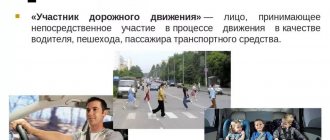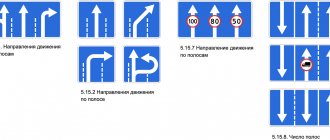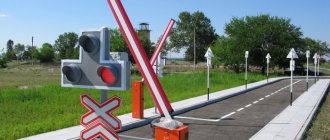Fines for speeding on the highway
Penalties vary depending on whether the violation was recorded by a highway patrol officer or a camera.
Recorded by employee
Below is a table of the distribution of fines if the car is stopped by an inspection officer. The more serious the violation, the higher the monetary damages.
| Over speed | First violation | Repeated violation |
| 0–20 km/h | — | — |
| 20–40 km/h | 500 ₽ | 500 ₽ |
| 40–60 km/h | 1–1.5 thousand ₽ | 2–2.5 thousand ₽ |
| 60–80 km/h | 2–2.5 thousand ₽ / deprivation of a driver’s license for up to six months | deprivation of driver's license for a year |
| from 80 km/h and above | 5 thousand ₽ / deprivation of a driver’s license for a year | deprivation of driver's license for a year |
A repeated violation is one that occurs again less than a year after the first.
Recorded by camera
Distinctive features of violations recorded by the camera:
- The violator cannot be deprived of his driver's license or reprimanded in this case.
- The maximum possible fine is imposed if the article in this case provides for deprivation of rights.
- Otherwise, the minimum possible fine will be imposed.
Below is a table of monetary penalties.
| Over speed | First violation | Repeated violation |
| 0–20 km/h | — | — |
| 20–40 km/h | 500 ₽ | 500 ₽ |
| 40–60 km/h | 1 thousand ₽ | 2 thousand ₽ |
| 60–80 km/h | 2.5 thousand ₽ | 5 thousand ₽ |
| from 80 km/h and above | 5 thousand ₽ | 5 thousand ₽ |
Moreover, if the driver pays these fines within 20 days from the date of recording, he can receive a discount of 50% of the fine.
| Over speed | Discount for first violation | Discount for repeat violation |
| 0–20 km/h | — | — |
| 20–40 km/h | 250 ₽ | 250 ₽ |
| 40–60 km/h | 500 ₽ | no discount |
| 60–80 km/h | 1250 ₽ | no discount |
| from 80 km/h and above | 2.5 thousand ₽ | no discount |
Fines for speeding on the highway
The amount of the administrative fine for exceeding the permitted speed varies depending on the severity of the violation.
That is, the faster you drive, the more severely the offender will be punished.
An administrative fine is imposed on the offender in accordance with Article 12.9 Part 2 of the Code of Administrative Offenses of the Russian Federation. This article for violating the rules established by traffic rules implies the following penalties:
- 500 rubles – for driving 20-40 km/h faster from the established upper limit;
- 1-1.5 thousand rubles – for driving 40-60 km/h faster than the permissible limit;
- 2-2.5 thousand rubles or deprivation of driving license for a period of 4 to 6 months, for exceeding 60-80 km/h;
- 5 thousand rubles and deprivation of rights for six months - for driving 80 km/h or more in excess of the norm.
Since fast-moving vehicles cannot be stopped urgently in an emergency situation, therefore, when accelerating, the driver must take into account not only traffic regulations and road signs, but also the technical characteristics of the vehicle, as well as the situation on a specific section of the road (visibility, congestion, quality of the road surface) and weather conditions.
Source
Permitted speed on the highway
The values are based on many indicators: type of road (motorway or regular), type of transport, etc.
Speed on motorways
According to clause 16 of the traffic rules, on highways the lower speed limit is 40 km/h.
The highest permitted speed on motorways is 110 km/h. However, if the highway passes through a populated area, it cannot be more than 60 km/h.
The speed can be increased to 130 km/h, but only taking into account the fact that:
- there is a 3.24 sign with the number 130;
- there is a sign 5.1.
This combination of signs is rarely found on highways in the Russian Federation. Since the restrictions directly depend on the quality of the roads, there are only a few such routes, mainly in the European part of Russia. They are listed below..
M11 Moscow - St. Petersburg.
M11 Moscow — St. Petersburg
Speed on normal roads
On ordinary roads, the permitted speed is determined by the type of vehicle. For passenger cars, the highest value is 90 km/h. But a lot depends on the signs.
Thus, sign 3.24, which was mentioned earlier, is almost the most frequently encountered by drivers on standard roads. It prohibits prohibits driving at a speed higher than indicated on the sign
There is a sign increasing the speed limit if the roads allow it. Example: if sign 3.24 shows the value “90”, the permissible speed limit for normal-heavy trucks, whose upper limit is 70 km/h, will increase.
There is also the concept of “step speed increase”. If on a certain segment the speed needs to be gradually increased or decreased, sign 3.24 is installed every 100–150 meters with a change in the permitted speed by 20 km/h. For example, when carrying out unplanned work on a given section, a series of signs at some distance from each other may show “80–60–40”.
There are also signs 6.2 (driving on a country road is recommended at the indicated speed) and 4.6 (you can only drive at this speed or higher).
In populated areas, even the most sparsely populated areas, a passenger car must reduce speed to 60 km/h.
Requirements for intercity transportation
For intercity passenger transportation in the bus, the following package of documents is required:
- a notarized copy of the license of a legal entity (carrier company), granting the right to carry out passenger transportation activities;
- driver's license category D;
- unlimited MTPL insurance policy;
- waybill;
- a certificate indicating that the driver has passed a medical examination;
- diagnostic bus technical inspection card;
- certificate of registration of the vehicle with the assignment of state numbers;
- technical passport of a passenger bus.
Requirements for the driver to ensure safety measures:
- monitoring passenger compliance with safety measures;
- boarding and disembarking people only after the vehicle has come to a complete stop;
- storing luggage in luggage compartments (upper and lower), the presence of which is mandatory on long-distance buses;
- driving the bus strictly along the established route (deviation is possible only with the permission of the carrier company).
Carrying passengers in a standing position is permitted only if the following conditions are met:
- the distance between the points of departure and arrival does not exceed 70 kilometers;
- The cabin has handrails and enough free space to accommodate people comfortably and safely.
If the duration of the route exceeds 500 kilometers, the presence of two drivers is required for one flight.
In intercity transport, emergency exit signs and instructions for their use and a list of rules for using the vehicle must be placed.
In what cases should a bus driver drive at an average speed below the maximum permissible?
When transporting passengers on highways or within a populated area in non-standard road conditions, the driver can and must decide to drive the bus at an average speed lower than the permitted speed. This decision may be prompted by:
- traffic on this section of the road is of increased intensity;
- difficult weather conditions – poor visibility or slippery surfaces;
- technical condition of the vehicle.
If a potential hazard is detected, the driver must slow down or stop.
Source











